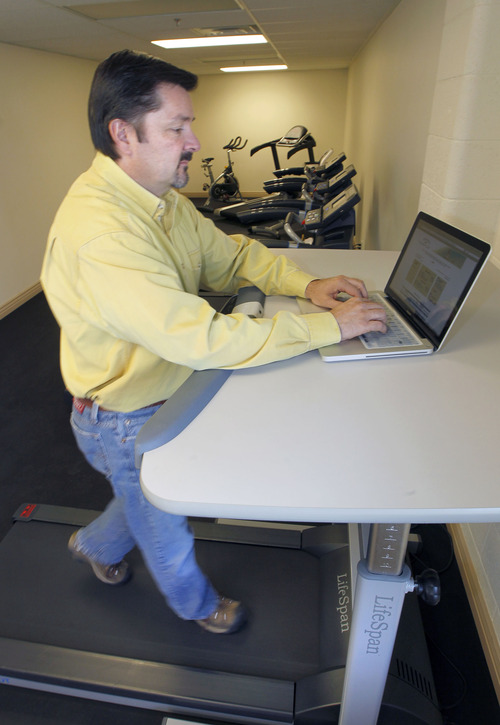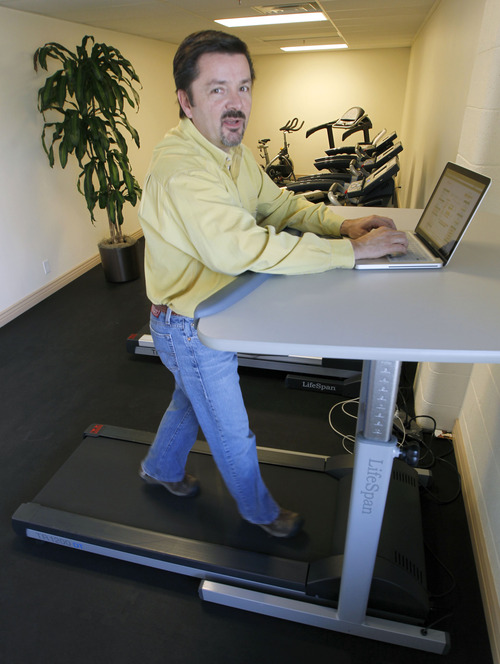This is an archived article that was published on sltrib.com in 2012, and information in the article may be outdated. It is provided only for personal research purposes and may not be reprinted.
Thanks to a new type of treadmill from Salt Lake City-based PCE Fitness, people can do more than just walk to work for exercise. They can walk while at work.
The private company, makers of the LifeSpan series of fitness equipment, has created a line of treadmills that health-conscious employees can use at the office, complete with a stand-up desk at which they can work while walking.
"We've got to be moving much more frequently," company president Pete Schenk said. "They [researchers] are starting to call inactivity the new smoking."
So PCE Fitness has created two lines of treadmills that help workers get off their chairs to take a daily stroll in their own offices. Its "workplace solutions" line includes six different models of treadmills without the traditional control station and handle bars regular treadmills have. Instead, they work with stand-up office desks.
Three of the treadmills (priced from $799 to $1,499) include a small book-sized control pad that operates each unit. The stand-up desk is sold separately. The other three models (priced from $1,299 to $2,499) come with a desk with the control pad built in. Both sets of models also have built-in wireless Bluetooth connectivity so the number of steps you take, calories burned and other exercise-related information can be transmitted to a software program on your laptop. The more expensive models even include a USB charging port for your computer or mobile devices.
"One of the things about them is they have a really small footprint," said Elizabeth Joy, an Intermountain Health Care medical director and University of Utah adjunct professor of family and preventive medicine who bought some of the LifeSpan treadmills for research with medical students. "They really don't take much space at all. The treadmill and the desk is probably smaller than most office workstations."
The idea of exercising on a treadmill while at a desk came out of research from Mayo Clinic endocrinologist James A. Levine in 2005. He has been studying the effects of sitting on long-term health.
According to his research, sitting for long periods increases the risk for high blood pressure, higher blood sugar and cholosterol levels. Levine said those who sit twice as long during the day while watching TV or other "screens" increased the risk of death by any cause by 50 percent. Events associated with cardiovascular disease or heart attack also rose by 125 percent.
Joy said there has been a rise of inactivity in the world, largely due to changes in technology that have taken away our ability to do things ourselves.
"We have designed a clicker for everything. Why get out of your chair to do anything when you have a clicker? It's just kind of endemic," said Joy, who walks about four hours a day on her own "walkstation" treadmill in her office. "The moving sidewalks at airports are an example. In kids, we see them participating in less physical education in school. It starts and it almost becomes normal not to move. It's almost cultural."
Schenk, who formerly worked for American Stores and Intel, started PCE Fitness in 2002 from his "passion for exercise and fitness and a love for product development."
His idea was to focus his line of fitness equipment, which includes treadmills and exercise bikes, on normal users while other companies were already marketing to "six-pack [abs] customers."
"I felt the average customers' needs were left unmet, and they have a different set of needs," Schenk said.
Today, he has more than two dozen models of exercise equipment for sale, which are sold at retail outlets as well as online at www.lifespanfitness.com">http://www.lifespanfitness.com. Though PCE Fitness is considered one of the smaller fitness companies among more than a dozen competitors worldwide, Schenk believes his focus on the average customer and his move into treadmill "walkstations" for the office is the right thing to do.
"We have grown an average of 30 percent a year compound growth, and that's kind of where we want to be," he said.
Tips to keep walking at work
Mayo Clinic endocrinologist James A. Levine, who is researching the effects of inactivity at work, recommends these tips to keep moving while in the office to help maintain a healthier lifestyle:
Stand up when answering your phone. Pace around the desk during the call.
Conduct more "walking meetings" if you meet with just one or two other people and aren't required to take notes.
Cut back on emails and phone calls to co-workers. Instead, walk to their desk.
Follow a 10-minute rule. Whenever you're working at your desk, get up for 10 minutes every hour to stretch.
Take the stairs instead of the elevator.
Park your car farther from the office than before.
Take a midday stroll during part of your lunch.





